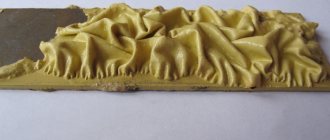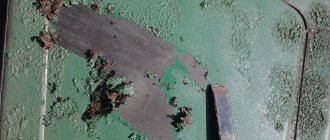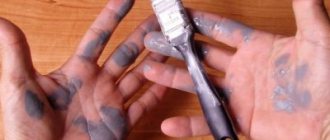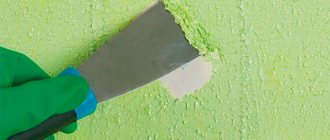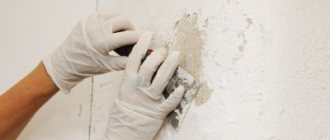The scope of application of acrylic paints is very wide. This material is used by both artists and builders. If an ordinary person opens a jar of acrylic, he may be surprised at the high density. Out of ignorance, many people immediately start working, which leads to a lot of problems in the future. Below you will find out why you need a solvent for acrylic paints and how to work with the substance correctly.
Advantages of acrylic paint
Acrylic dye is universal. It is used for metal, wood, and glass surfaces, painted on canvas, used in the restoration of old furniture, and created unique designs on walls.
- Acrylic is environmentally friendly and harmless to health , as it does not contain harmful substances.
- Thanks to the water in the composition, it dries quickly.
- A variety of colors and shades that can be matched to any interior.
- There is no unpleasant odor, so you don’t have to open the windows for ventilation when working.
- The surface coated with acrylic dye does not interfere with air exchange.
- The breathable coating is moisture resistant.
- Acrylic does not allow dust to accumulate and is very easy to clean.
- Long service life, paints do not wear off and do not fade in the sun.
How not to dilute enamel for heating radiators
The appearance of cast iron heating radiators requires periodic updating. This is necessary not only for aesthetics, but also to extend service life. Aluminum and steel radiators have a special powder coating and, as a rule, do not need to be repainted. Today there are many varieties of paints on sale designed specifically for radiators. Enamels are best suited for cast iron batteries. Which ones exactly, how to apply them correctly, what can and cannot be used to dilute enamel paints - we will talk about this below.
Solvent or thinner
Let's look at the differences between a thinner and a solvent, because sometimes these concepts are replaced. It is necessary to understand what each option is suitable for, so as not to spoil the composition of acrylic and not deteriorate its quality.
The solvent thins the paint and makes it easier to remove from any surface. The properties of the coating may deteriorate, and the drying time may also change. The solvent easily removes the dried layer.
The thinner will not impair the properties, but if added in large quantities it can change the density. The paint in a diluted state does not lose its quality, only the density of application and color saturation changes.
Water is the main diluent of acrylic, and manufacturing companies offer special solvents , which will be discussed below.
Prevention measures
In order for the paint to continue to remain liquid and not dry out, you do not need to start unpacking the kit and opening the dyes if you do not intend to paint in the near future. If the paints have already been unpacked, then they must be carefully closed and stored in a dark place.
A good option might be a heated basement, garage, closet, or storage room.
It is also worth mentioning once again the need to tightly close the lids of containers with dyes. After each lesson, lids should be cleaned of dyes, and the same should be done with the necks of containers. Several layers of dried dye on the lid and neck will not allow the container to be closed tightly, and there will be no question of tightness.
You can’t leave dyes open for a long time, much less leave them while painting. No need to paint outdoors. As already mentioned, this speeds up the hardening of the dyes. Dirty, low-quality or dry paint brushes also do not have a beneficial effect on dyes.
Brushes should be rinsed under running water after each use and lightly wetted before use.
Solvent for acrylic paint
Water-based paint dries quickly when open. To be able to work with it, it is first diluted. The thick texture of the dye causes problems when dyeing. It will not be possible to apply it evenly, and traces of working tools will remain on the surface.
Solvent is gradually added to acrylic paint with constant stirring for a homogeneous structure. The composition should not separate or curl. To easily change color, special colors are used, with their help interesting color solutions are obtained. They are added before applying paint to the surface. Only then will the color be bright.
A comfortable working consistency should resemble sour cream in its thickness. If a spray gun is used, then the acrylic is diluted to the state of rich milk for uniform spraying. After completing the painting process, the paint can is hermetically sealed to prevent it from drying out as much as possible.
Dye dilution process
The dilution technology depends on the stage of solidification of the substance.
Dilution with water at the first stage of drying
If you find too thick dye in the jar, water will help correct the situation. Using a pipette or syringe, add 2-3 drops of clean liquid, mix and close the lid tightly. After 10 minutes the enamel will be ready for use.
Dilution at the second stage of drying
If the material has the consistency of soft plasticine or a rubber eraser, it can be softened with a proprietary thinner, which is added according to the instructions on the label.
The second way to soak hardened acrylic in a small container:
- take a toothpick;
- make 5-6 holes in the paint;
- pour boiling water and immediately drain the water;
- repeat the manipulations 2-3 times;
- pour boiling water onto the surface again, close the jar tightly and leave for 12-16 hours;
- After the time has passed, open the container and drain the water;
- mix the contents with a toothpick;
- Add boiling water in portions, slowly and smoothly, 1 drop at a time, until you get the desired consistency.
Do not shake the paint, otherwise it will become covered with lumps.
Restoring completely dried paint
Completely hardened enamel, which looks like stone, is difficult and almost impossible to melt.
Experienced craftsmen advise using a special solvent, alcohol or nail polish remover.
There is another method for restoring acrylic that is pulled out of a jar in one piece:
- remove solid material from the container;
- grind with a sharp object to a finely granulated powder;
- pour boiling water or heat in a water bath;
- mix thoroughly until smooth;
- Place in a jar and close with a lid.
To restore completely hardened enamel, you can use a special solvent.
Water
Water acts as the main diluent. Only cold and clean water is used, without foreign impurities. Before adding water to the paint, collect water and let it sit for several hours to avoid the ingress of solid particles. Using a special mixer, the mixture is brought to the desired consistency. The coating acquires water-repellent properties; all used brushes and other tools must be washed after painting. Otherwise, they will dry out and become unusable.
Water dilutes the paint without changing its properties. The layer is durable; only the saturation and brightness vary. When heavily diluted, the coating becomes translucent. Please note that after drying the paint may change slightly in color , so first apply it to a small area and observe the final result. If everything is satisfactory, then the entire surface is painted.
Features of dilution with water
Before diluting acrylic, you need to conduct a preliminary test to determine the desired proportions. Water is diluted in the following ratio: one to one, two, five, fifteen.
- With the first option, diluted acrylic is well applied to any surface; although the paint is thick, it covers well, and the coating is uniform.
- The one to two option allows you to work with a liquid structure that does not flow much and is easy to pick up on the brush. The surface after application is smooth and the layer is thin.
- A proportion of one to five makes the paint look like water; it is impossible to achieve saturation of the layer. A colored liquid that absorbs well is convenient for painting figured parts.
- A ratio of one to fifteen turns acrylic into ordinary water with little color content. It is used not for coloring, but for smooth transitions from one shade to another.
What proportions should I keep?
The classic version of painting work offers four main types of proportions for diluting acrylic paint with water:
- Proportions 1:1
. By adding the same volume of water to the volume of paint, you will get diluted paint, which is suitable for applying a base coat. The paint will be thick, but will not stick to the brush or roller. This consistency will spread evenly over the surface. - Proportions 1:2
. By adding a double portion of water per volume of paint, you will get a light, flowing mixture that can be applied to a brush or roller in a thin layer. This consistency is used when you need to make a lighter shade on a smooth wall. - Proportions 1:5
. Exceeding the volume of acrylic paint with water five times, we obtain a completely liquid composition. The liquid penetrates between the bristles of the brush and forms an inconspicuous layer when applied. This consistency is well suited for painting textured products. - Proportions 1:15
. This dilution produces water with a small admixture of dye. This ratio is practiced by painters to reproduce smooth transitions from one shade to another.
Important!
When diluting acrylic paint, pour water in small portions and stir constantly.
Use measuring instruments so as not to miscalculate the required volume of water for dilution. Among such tools are a measuring cup or a syringe.
Acrylic-based paint is one of the popular materials for decorating building facades and carrying out interior work. It is quite easy to apply, but due to its thick consistency, the coating sometimes turns out uneven or too rich. This problem can be easily avoided if you know how to dilute acrylic paint.
Proprietary solvent
There are special tools with different tasks. Solvents recommended by manufacturers may change the texture of acrylic paint. For example, you can make the coating matte or shiny; the properties can be read on the label.
Acrylic solvent is a colorless liquid with a characteristic odor. If you add a lot of it, the coating layer will be translucent; when diluted with a small amount, the color will remain rich. When spraying acrylic with a spray gun, it is best to use a proprietary solvent for dilution. In this case, a consistency suitable for the job and uniform application of the composition are guaranteed. The acrylic paint solvent allows you to change the shade and affects the strength and appearance of the coating. The paint should only be diluted with fresh solvent.
The compositions differ in drying time. Manufacturers recommend using a solvent with a high evaporation rate when working in cold and humid weather, and a low evaporation rate in hot weather. Solvents must , preferably in the dark and cool, in strict compliance with fire safety standards.
Causes of drying out
If the paint for paintings by numbers has dried out, then this is due to the influence of the following factors or actions.
- The manufacturer violated manufacturing technology or used low-quality materials.
- The paint container was not tightly closed. Obviously, in this case the paint dries very quickly.
- The paints were stored under conditions different from those described in the instructions. In particular, the rays of the sun have a particularly destructive effect on them.
- Paints can also dry out if painting takes too long and the lid is not closed during this time.
- The dye dries out if it is opened too often.
- Paints often dry out after the expiration date.
- If the container is damaged during transportation or use, drying out cannot be avoided.
- Paint dries faster in the fresh air than indoors (provided the lid is open).
- As already mentioned, it is undesirable to expose dyes to direct sunlight. Under their influence, the solvent in the paint evaporates faster.
Types of solvents
The most popular options are glossy and matte. They are used to improve the appearance of the coating. They are a transparent solution with a slight odor that disappears after drying. The surface is shiny, bright or, conversely, matte without gloss.
Solvent-removal. Removes dried paint from any surface and cleans brushes. It is a gel-like paste with a pungent odor. The remover is applied for 15 minutes, during which time it dissolves the acrylic and the coating can be easily cleaned. However, it will not remove paint from the skin. If it gets on the face or body, the chemical composition is immediately washed off with water.
General information
Next, we will look at the most popular of them, because the result and quality of your work will depend on the correct choice of solvent for acrylic paints.
Difference between thinner and solvent
Despite the fact that the words are very similar in meaning, incorrect use of these components can ruin not only the paint, but also the finished result. To avoid having to run to the store for a new can of paint, you should remember these differences.
The thinner does not particularly affect the quality of the product itself, but it changes the color saturation and also changes the thickness
It is important to remember that when using a thinner, the paint dries faster, and therefore you have to work with it in an accelerated mode
The solvent is useful when the task is to wash off paint from a surface or remove a dried layer. At the same time, acrylic becomes more liquid, and accordingly, the drying time increases significantly.
Types of solvents for acrylic paints
Acrylic is never used in its pure form for painting or finishing work. Due to rapid drying, there is a high probability of obtaining an uneven surface with marks from a brush or sponge. For the same reason, it is recommended to wash the tools used, especially brushes and rollers, immediately after finishing work. Otherwise, after the paint has dried, it will be easier to purchase new brushes than to clean the old ones.
How to revive dried paint?
It often happens that the acrylic left after painting dries out. The water evaporates and the paint loses its quality characteristics. The irreversibility of the process leads to the fact that only through dilution can the paint be revived. Just remember that it will not acquire its previous properties.
If the acrylic paint is very dry, then grind it into powder with a sharp object and then pour boiling water over it. After a few seconds it is drained and the manipulation is repeated. After sufficient heating, the paint can be stirred. True, it will no longer have a uniform structure, but it can be painted.
Some craftsmen manage to resurrect paint that has turned into a tight clot. To do this, carry out the same procedures by adding alcohol to the water. Of course, in this case there is no point in talking about good coverage.
Decorative coating components
Before using this or that paint, it is advisable to understand what substances are included in it. After this, most likely, the problem of choosing a solvent will disappear by itself.
All acrylic paint mixtures have three main components:
- water;
- coloring pigment;
- binders.
The last ingredient in acrylic paint is a polymer emulsion, which contains acrylic. This determines the choice of name for the decorative material in question.
Paint has a very wide range of applications: from facade work to coating indoor surfaces. In this case, it practically does not matter what material is painted.
In addition, one of the features of a paint composition containing acrylic is its resistance to ultraviolet radiation. Therefore, the surface remains bright and attractive for a long time.
Well, the last advantages are the price, which makes the finishing material in question one of the most affordable on the market, and ease of use, which is especially important if you decide to carry out repairs yourself.
Coloring Tips
The consistency of the paint affects the final result, so special attention is paid to the dilution process. You need to dilute it to a comfortable thickness, allowing you to create an even coating without streaks or traces of a brush or sponge. If there are any doubts about any matter, the instructions will answer all questions. When opening the can, a film may be found on the surface of the acrylic paint ; it should be removed rather than mixed to avoid the appearance of lumps.
If you have to paint a small area, then a brush will be enough; for a larger volume you will need a roller or a paint sprayer. Visible joints are shaded; to obtain a smooth surface, do not make cross movements. It is best to apply acrylic in two layers. If a break is used during the painting process, the brushes must be washed.
Acrylic paints are easy to work with. They are universal and suitable for both external and internal work. By following simple instructions for diluting paint, you can achieve wonderful results. If rework is required, a solvent will again come to the rescue , which will easily remove the old layer and free up the surface for a new coating.
Conclusion
Before using acrylic paint, in most cases it must be diluted with water or a solvent. Using the tips given in the article, you can get material that best suits your needs. With its help, you can bring your wildest design fantasies to life.
You can learn more about painting from the video in this article.
Widely used in renovation work, both indoors and outdoors.
These mixtures are easy to use, but the point is that they have a thick consistency and must be diluted.
Otherwise, the coating will be uneven or too saturated. How to dilute acrylic paints to the required thickness and how to do this?
Acrylic paints appeared half a century ago. Since then they have gained well-deserved popularity.
These products can be used to paint any surface: wood, metal, and even. They have many advantages among other coloring substances, including:
- An environmentally friendly substance, it is safe because it does not contain elements that poison the environment.
- They are easy to work with because they do not have a bad smell.
- They have a huge number of different color shades, which is not found in other types.
- The mixture dries quickly and you don't have to wait long to use the painted item.
- The surface after painting becomes smooth, it is easy to clean, and the paint does not wear off.
- Dust and dirt do not accumulate on it.
- The painted area “breathes” but does not allow moisture to pass through.
- The paint is of high quality and does not require renewal for 10 years.
The composition of the mixture is as follows:
- coloring pigment
- connecting elements
The role of the binding element is played by an acrylic-based polymer emulsion, hence the name of the mixture in question.

